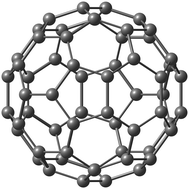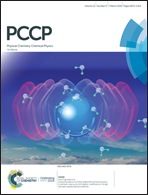Distinguishing artificial and essential symmetry breaking in a single determinant: approach and application to the C60, C36, and C20 fullerenes†
Abstract
We present a thorough analysis of symmetry breaking observed in Hartree–Fock (HF) solutions of the C60, C36, and C20 fullerenes in order to characterize the nature of electron correlation in them. Our analysis is based on (1) the critical regularization strength to restore symmetry breaking in the recently developed regularized orbital optimized second-order Møller–Plesset perturbation theory (κ-OOMP2), (2) singlet–triplet gaps from various MP2 methods, and (3) natural orbital occupation numbers from restricted coupled-cluster with singles and doubles (RCCSD) and coupled-cluster valence bond with singles and doubles (CCVB-SD). Based on these three independent probes, we conclude that C36 (D6h) exhibits genuine strong correlation and symmetry breaking whereas C60 exhibits artificial HF symmetry breaking and is not strongly correlated. Investigating the critical regularization strength, we discuss strong correlation in C20 at the Jahn–Teller distorted geometries (C2h, D2h, Ci, and D3h) and the Ih geometry. Only C20 (Ih) was found to be strongly correlated while others exhibit artificial HF symmetry breaking. This analysis highlights a useful feature of the recommended κ-OOMP2 method. It is an electronic structure method that describes dynamic correlation, and attenuates strong correlation in MP2 towards zero by regularization. Therefore, κ-OOMP2 will exhibit symmetry breaking in its reference determinant only when correlation is strong (i.e., essential symmetry breaking). Artificial symmetry breaking (arising in HF due to neglect of dynamic correlation) thus appears to be removed in κ-OOMP2.

- This article is part of the themed collection: 2019 PCCP HOT Articles


 Please wait while we load your content...
Please wait while we load your content...
